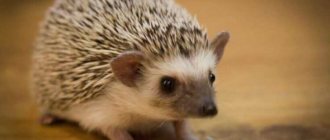Appearance
Chameleons are lizards with a laterally compressed body, a short neck and a long, tapering tail. With this tail, which curls into a spiral, they can grasp branches and hold tightly to trees.
The skin of chameleons is covered with tubercles, and many species have horns or some kind of crest on their heads.
The paws, like human hands, have five fingers that look like small pincers. This shape of the legs allows you to cling to even the thinnest branches.
The eyes are round and surrounded on all sides by skin with a small hole for the pupil. They have a very interesting feature: they can rotate independently of each other 360 degrees.
The tongue is very long and, when extended, is longer than the body and head.
Interesting! Chameleons do not have middle or outer ears, and therefore have poor hearing.
There are more than 135 species of chameleons, which differ in habitat, color and size. For example, the length of the animal can vary from 15 mm. up to 68 cm
Who eats chameleons in the wild?
Tree lizards have no protection from predators. In case of danger, they are able to change color and inflate, trying to appear larger. If the chameleon sees that the measures it has taken have been ineffective, it tries to hide by deftly jumping from branch to branch.
Natural enemies of arboreal reptiles include birds, snakes, larger reptiles, and some mammalian predators.
AXOLOTL
Color change
Chameleons change color in two cases: when in danger and during hunting. They adapt to the surrounding temperature and lighting, thereby becoming completely invisible. of geckos can change their skin color .
Some species can only change their color from green to brown, which allows them to successfully hide in the canopy of trees. Other species can take on almost any color. They do this quite quickly: the color change can occur within 20 seconds.
How does color change occur? To begin with, all chameleons are born with a set of certain cells that have their own pigment, called chromatophores.
They are found under the outer skin of chameleons. Receiving a message from the brain, chromatophores change their color, depending on whether they were given the task of expanding or contracting.
At this moment, the same process occurs as on the artist’s palette: the colors are mixed with each other, creating a completely new shade.
Scientists have long come to the conclusion that it is not only the environment that influences color changes. For example, a new shade shows that the chameleon is calm or helps it communicate with other individuals of the same species.
Advertising often uses a trick where the chameleon takes on any color, including a wallpaper pattern or a chessboard pattern. This is a popular stereotype, because the animal’s capabilities are limited and no ornaments are within its control.
True, some types of chameleons can copy the color of the leaves along with the veins. In order for the camouflage to be even more reliable and the individual to completely merge with the leaf, it can freeze for several hours in an uncomfortable position, tearing off a pair of paws from the branch.
Chameleons can change color not only in case of danger or during a hunt, but also in order to communicate with other individuals.
general information
This exotic animal is called an unprincipled person who changes his views very easily depending on the situation. Chekhov added fame to this image. Perhaps, because of his famous story, our people have a somewhat negative chameleons
Unlike human chameleons, the chameleon animal is completely harmless, at least for people. The main feature of the chameleon is its unique camouflage - the ability to quickly change color under the influence of the color of the environment, light, and temperature. It was this amazing property of the animal that the masters of the pen used. By changing the color of its skin, the chameleon becomes invisible to predators. Such disguise is his only way of protection.
The oldest known chameleon was found in Europe (the find is approximately 26 million years old). However, chameleons are probably much older than this (there are finds dating back more than 100 million years). Fossils have also been found in Africa and Asia, and it is believed that chameleons were once more widespread than they are today. They may have their origins in Madagascar, which today is home to almost half of all known species of this family, then dispersed to other lands.
Habitat
Most of the known species of chameleons, and there are about 135 of them, live in Madagascar or Africa. Several species are found in Asia and only one, the common chameleon, is found in Europe.
These amazing animals live only where the climate is warm, as they belong to the class of reptiles. During cold weather, chameleons hibernate.
They live mainly in trees. Their natural color is most similar to the color of the bark and leaves: green, brown, beige, yellowish.
As mentioned above, thanks to their long powerful tail, these animals feel calm among the branches.
Firmly grasping thick branches with their tails and fingering thin branches with tenacious fingers, chameleons occupy the most comfortable position for hunting or resting. In this position, almost motionless, they can spend up to twenty hours.
They descend to the ground only during hibernation or reproduction. However, there are a couple of species that lead a terrestrial lifestyle.
Interesting! Almost half of all chameleon species known to science live in Madagascar.
Chameleons belong to the class of reptiles and therefore prefer warm climates. When it gets cold they hibernate
Distribution area of reptiles
Chameleons live mainly in the eastern hemisphere. Some of their varieties are found exclusively in Madagascar. Here, in the closed conditions of the island, these creatures acquired unusual characteristics, which are the result of adaptation to the conditions existing in this area. Among the places where chameleons live, tropical forests of Africa stand out. Some lizards live in the hottest deserts of the African continent.
Thanks to their unique adaptability, chameleons survive well in conditions where there is practically no water and food supplies are quite scarce. The range of some species of chameleons extends to the islands of the Mediterranean Sea and the southern part of Turkey. In addition, 1 species of these creatures is found in India. Another variety is found on Tseloina and the island of Socorta. Some species of these animals are so rare that not all naturalists manage to take at least one photo of these creatures in their entire lives. The reasons for the rapid decline in the numbers of some species of these amazing lizards are deforestation and urbanization of their habitat areas.
Lifestyle
As a rule, chameleons, like many other reptiles, including salamanders , lead a solitary lifestyle. Despite the fact that these lizards are very inactive and can only move a couple of centimeters during the day, they are always ready to catch an insect. Their eyes and tongue are ready.
When two males meet, a fight may occur. There are times when they begin to hiss at each other and try to drive away the opponent, but most often they go their separate ways in peace.
Some chameleons gather on branches in groups of 5-6 individuals.
Chameleons prefer to lead a solitary lifestyle, but sometimes gather in groups of several individuals
Diseases and health problems in chameleons
The structural features of the body of these exotic creatures directly affect the presence of diseases common in their environment. In fact, they often get sick due to problems with the eyes and vision (including the musculo-ligamentous apparatus of the eyes), burns, disturbances in the gastrointestinal tract, lack of vitamins and minerals in the body, which leads to rickets or other malfunctions balance of the reptile's body.
Everything is complicated by the fact that pet diseases arise rapidly and develop extremely quickly - therefore, untimely provision of qualified veterinary care can lead to the death of a chameleon even from a not particularly serious illness.
Food intoxication may also occur, which is usually caused by regular overfeeding of the lizard. Pronounced symptoms of this condition include reptile lethargy, loss of appetite, and constipation. If a chameleon has a weakened immune system, viral diseases cannot be ruled out. When you notice signs such as coughing (immediately rule out the possibility of pneumonia, since lizards do not tolerate temperature changes, drafts and cold), bloating, apathy and lethargy, then most likely your pet is suffering from a helminthic infestation. This problem can be observed in those chameleons that were caught in the wild before getting into the pet store.
The owner of an exotic animal should be alarmed by the slightest disturbance in the behavior of a chameleon - this is a reason to immediately contact a veterinarian. Taking into account all the specifics of these vulnerable creatures, experienced reptile owners immediately take their pet to a herpetologist, and not to the usual veterinary doctor: only this specialized reptile specialist is able to quickly provide adequate and professional assistance to a sick chameleon.
JACKSON'S CHAMELEON: DESCRIPTION, PHOTO, CARE, CONTENTS
YEMEN CHAMELEON: DESCRIPTION, CONTENTS, PHOTO, REPRODUCTION
Nutrition
The main food of chameleons is insects, which they catch in large quantities. Sometimes plant foods, fruits and water are added to their diet. Large species can eat small lizards and small birds. https://profikarkas.com.ua/ - frame houses in Kyiv
Chameleons easily tolerate hunger, but it is quite difficult for them to tolerate thirst.
The main diet of chameleons consists of insects. They can also eat the fruits of trees and be sure to drink water.
Hunting
Thanks to their long, powerful tongue and eyes that rotate in different directions, chameleons are quite successful hunters. Noticing the victim, they direct both eyes at it and “shoot” their tongue in its direction.
The tip of the tongue takes the shape of a cup, and the caught insect is sent straight into the mouth of this unusual lizard. Hunting is also helped by the fact that the tongue acts like a suction cup. This deprives the victim of any chance of salvation. The capture takes a tenth of a second.
The tongue can hold food weighing up to 50 grams, and it can also take a position in which it becomes possible to grab an insect located on the opposite side of the leaf.
Chameleons wait for prey very patiently, sitting motionless for hours. But all this does not mean that they are lazy and clumsy: if necessary, chameleons can not only run fast, but also jump through trees.
Interesting! Chameleons have good vision for reptiles and can see even a small insect from a distance of up to 10 meters.
Chameleons have unusual vision: their eyes can rotate independently of each other 360 degrees, which allows them to immediately see the victim and prevent danger to themselves
Vision and other features
Chameleons have large , complex eyes . The eyelids are fused, but there are holes for the pupil.
REFERENCE! Israeli neuroscientists have proven that reptile vision is not chaotic. Although the eyes move independently 180 degrees in the horizontal plane and 90 in the vertical.
The control of the brain hemispheres is finely tuned, allowing you to track 2 targets.
The eyes located on the sides see the big picture.
- One watches potential prey.
- The other monitors the surrounding environment.
IMPORTANT! At the moment of the attack, both look at the victim, the distance to which is determined very clearly.
Lizards are excellent at distinguishing close objects. Some are able to see in the ultraviolet spectrum, which makes it easier to find relatives and prey in the dark.
Reproduction
During the mating season, males behave aggressively towards each other. All their actions are aimed at driving away the rival and proving to the female that they are the most suitable candidates for reproduction.
Male individuals hiss, fight, are driven out of their territory, and can fight with their antlers, as deer do. A change of color to a brighter and more frightening one is also used.
Chameleons use several methods for reproduction: some species lay eggs, which is typical for most reptile species, others are viviparous, and in still others, females can lay unfertilized eggs without the participation of males.
Those species that lay eggs in the traditional way bury them in the ground or hang them from tree branches. There can be from 15 to 80 eggs in a clutch, and the incubation period is up to 10 months.
In viviparous species, up to 14 young can be born. They are glued to the branches with mucus and fed this way for the first time.
Species where the female can do without a male are very interesting, because the resulting offspring are quite capable of a full life and further reproduction.
If adult chameleons protect themselves by camouflage, then the cubs are generally incapable of any self-defense. They move by clinging to the backs of their mothers.
Interestingly, different species of chameleons reproduce in different ways: some lay eggs in the traditional way, in other species the females, without a male, lay unfertilized eggs, and some species are viviparous
Home maintenance
Chameleons are kept in a terrarium, just like pythons , centipedes and other creatures that require a special humid microclimate. Caring for them is quite simple. It is necessary to arrange a place for them and periodically clean it.
Excellent species for an apartment are leopard and common chameleons. Many breeders choose Yemeni chameleons for their breeding. They adapt really well to new conditions.
It is best to have a vertical terrarium in which you can place branches at different levels. Choose deciduous plants and make sure that they do not have any thorns that could damage your pet’s paws.
A layer of sand is poured onto the bottom, which is recommended to be moistened with water from time to time. This will help maintain the required humidity level.
The same can be done with the walls of the terrarium: chameleons can lick the water with which you spray the walls. Place a drinking bowl-dropper.
Advice! Chameleons are very sensitive to temperature, so you need to monitor it closely. The temperature in the terrarium should be about 25 degrees. This will allow you to enjoy watching your pet all year round, otherwise, if it feels colder, it may go into hibernation. Also, at temperatures below 18 degrees, chameleons stop eating.
A pet chameleon will feel best in a vertical terrarium. The bottom should be covered with sand, branches of thornless trees should be placed at different levels, and temperature and humidity should be monitored.
Description
A special feature of chameleons is their ability to change colors. As a rule, they simply blend in color with their surroundings. This possibility is due to the special structure of the lizard’s skin. Its outer layer has a fibrous structure, which includes branched cells. They are rich in dark brown, yellow, red and black pigments.
Important! The predominance of the chameleon's green color is due to the refraction of ultraviolet rays in the outer layer of skin with guanine crystals.
Muscle contraction and cell redistribution result in different combinations of pigments. In turn, such a complex biological feature leads to the ability to change color in accordance with the circumstances.











